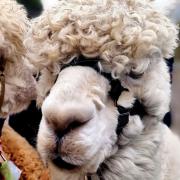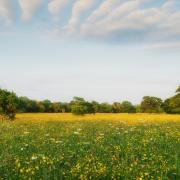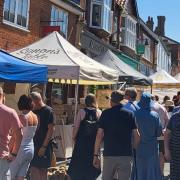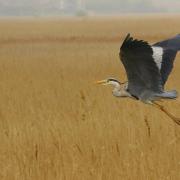These amazing creatures deserve our respect and protection, says Norfolk Wildlife Trust ambassador Nick Acheson
You’re not going to believe this: there’s an animal in Norfolk which can eat 3,000 midges and mosquitos in a single night. That’s every individual animal eating 3,000 insects in a night and doing so completely in the dark. By sound.
Yes, we too can hear mosquitos, whining annoyingly around our heads in bed on late summer nights. (The sound of a single one is enough to get my stepfather out of bed, flailing around the bedroom, much to my mother’s amusement.)
But this infuriating whine isn’t what I mean at all. These animals aren’t simply hearing mosquitos in the way that we are; they are catching them – on the wing, in perfect darkness – using sonar.
Oh, and the females among these animals are nothing short of geniuses. They mate in autumn, but because they hibernate through winter, the very worst metabolic state for growing an embryo, they don’t fertilise the egg until the spring, when there’s enough food around for pregnancy and lactation.
As for hibernation… well we all know that some animals do it. We’ve always known. But what does it actually mean?
In the case of these amazing little animals, it means dropping their heart rates from up to 1,000 beats per minute, while active, to as few as 20 beats a minute, while in their state of torpor. It means slowing breathing to as few as five breaths per minute; and oxygen intake to 100th of its rate when active.
Can we do any of these astonishing things? No, we emphatically cannot. Why then do we so disparage bats? For these dashing little animals, devourers of midges and masters of metabolism, are bats. And this is far from all that they can do.
A clarification first, though: when I say bats, I mean a wonderful diversity of them. In the UK alone we have 18 species of bat, 17 of which are known to breed here. (The last, the greater mouse-eared bat, has been represented here by just a single hibernating individual for 20 years, until this last winter when – oh brave new world! – a second individual was found, doubling the known UK population.) Bats represent just under a quarter of all our mammal species.
Broadly speaking the same ratio pertains on a global scale, where bats represent just under a quarter of all known mammals. Globally we know of – wait for it, drumroll – some 1,400 species of bat.

Around the world, especially in the tropics, these 1,400 species have evolved to do an astonishing variety of things, and in particular to eat an astonishing variety of foods. There are bats which eat insects, bats which eat frogs, bats which eat pollen, bats which eat fish, bats which eat fruit, and even bats which eat other bats.
And blood, I hear you say. Don’t start demonising bats on me now, people. Yes, there are bats which specialise in eating blood. But out of 1,400 species of bat on Earth, only three feed on blood. The others never take a sip. Not even a sneaky aperitif on Sunday, after a busy week.
The three vampires all live in Central and South America. So, you won’t be bumping into one here, despite all the Dracula propaganda from the anti-bat lobby. All our UK bats eat only invertebrates.

A dozen bat species occur in Norfolk. Several of them are found more or less everywhere there is open space. The tiny ones you may see flitting around your garden on spring and summer evenings may well be common pipistrelles. If you live close to water, you may also see soprano pipistrelles.
As their name implies, the clicks sopranos make, with which to navigate and locate their prey, are around ten kilohertz higher than those of common pipistrelles.
If you live near larger, wilder bodies of water, such as broads and lakes and rivers, you may also have Daubenton’s bats nearby. Whereas soprano pipistrelles often hunt around trees near water, these larger bats, with white bellies, skim the surface of a lake or river, scooping up insects with their feet.
Daubenton’s bat shares with the aye aye, Madagascar’s divergent, long-fingered, nocturnal lemur, the honour of being named after French physician and naturalist Louis Jean-Marie Daubenton. The genus name of the aye aye, and of its giant relative that was hunted to extinction within the last millennium, is Daubentonia.

If you live near woods, you will very likely have brown long-eared bats around you. Beautiful creatures, with enormous, curling ears, these little bats are woodland specialists, frequently gleaning insects directly from leaves or branches.
A much larger woodland bat, the noctule, is also widespread in Norfolk. Our heaviest species, and – with a lifespan of up to 30 years – one of the longest-lived, the noctule is the first bat to emerge in the evening.
It can be seen before dusk near woodland, flying high on long, sharp wings, as it hunts for the beetles and moths on which it commonly preys.

Most special of all, among our Norfolk bats, is the barbastelle. A blackish bat, identifiable by its pug-like nose and broad ears which meet above its face, the barbastelle is among the UK’s rarest mammals. And, from what little we know about it, Norfolk is its heartland.
The great majority of barbastelle breeding colonies known in the UK are found along the ancient valley of the River Wensum, many of them concentrated just northwest Norwich, in the country’s only known super-colony.
How sad that in popular perception and myth, these fascinating, beautiful animals are almost always loathed. How privileged we are to live beside them. And yet how perilously threatened they are. By us of course.
The 20th and 21st centuries have seen catastrophic declines in UK bats, because of our insatiable desire for land, for agriculture and development. Bats’ lives are astonishing and humbling, and our lives far better for the knowledge that they are all around us.
norfolkwildlifetrust.org.uk



























